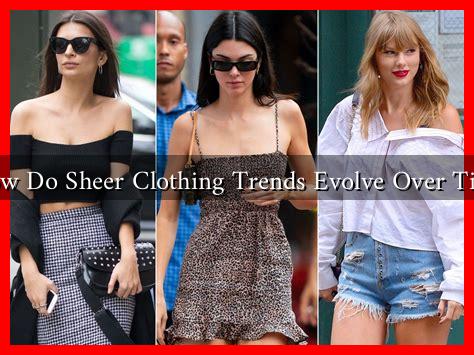-
Table of Contents
How Do Sheer Clothing Trends Evolve Over Time
Sheer clothing has long been a staple in the fashion industry, captivating audiences with its delicate and ethereal qualities. From the runways of Paris to the streets of New York, sheer fabrics have undergone significant transformations, reflecting cultural shifts, technological advancements, and changing societal norms. This article explores the evolution of sheer clothing trends over time, examining their historical context, contemporary interpretations, and future directions.
The Historical Context of Sheer Clothing
Sheer fabrics have a rich history that dates back centuries. Initially, sheer materials were used in garments to signify wealth and status. The use of lightweight fabrics like silk and lace can be traced back to ancient civilizations, where they were often reserved for the elite. Here are some key historical milestones:
- Ancient Rome: Sheer fabrics were used in togas and tunics, often layered to create a sense of elegance.
- Victorian Era: The introduction of lace and tulle in women’s fashion allowed for a more modest yet alluring aesthetic.
- 1920s Flapper Era: Sheer dresses became popular as women sought to express their newfound freedom, often featuring transparent overlays.
These historical examples illustrate how sheer clothing has been intertwined with social movements and cultural changes, often serving as a reflection of the times.
Contemporary Interpretations of Sheer Clothing
In recent decades, sheer clothing has experienced a resurgence, particularly in the realm of high fashion. Designers have embraced sheer fabrics, using them to create bold statements and challenge traditional notions of modesty. Some contemporary trends include:
- Layering: Sheer tops worn over bralettes or fitted tanks have become a popular way to incorporate transparency while maintaining a sense of style.
- Sheer Dresses: Designers like Alexander McQueen and Valentino have showcased sheer gowns that blend elegance with sensuality, often featuring intricate embroidery or embellishments.
- Street Style: Influencers and fashion enthusiasts have adopted sheer pieces in everyday wear, pairing them with denim or casual attire for a chic look.
According to a report by Statista, the global apparel market is projected to reach $2.25 trillion by 2025, indicating a growing interest in diverse fashion trends, including sheer clothing.
Case Studies: Iconic Sheer Moments in Fashion
Several iconic moments in fashion history have highlighted the allure of sheer clothing:
- Kate Moss at the 1993 CFDA Awards: Moss wore a sheer black dress that became a defining moment in fashion, showcasing the power of transparency.
- Rihanna’s 2014 CFDA Dress: Rihanna’s sheer crystal-embellished gown was a bold statement that sparked conversations about body positivity and self-expression.
- Gigi Hadid’s 2016 Victoria’s Secret Fashion Show: Hadid’s sheer wings and lingerie set exemplified the modern interpretation of sheer clothing, blending sensuality with high fashion.
These moments not only captured the public’s imagination but also influenced the direction of sheer clothing trends in subsequent years.
The Future of Sheer Clothing Trends
As we look to the future, sheer clothing is likely to continue evolving. Several factors will influence its trajectory:
- Sustainability: The fashion industry is increasingly focused on sustainable practices, which may lead to the development of eco-friendly sheer fabrics.
- Technological Innovations: Advances in textile technology could result in new sheer materials that offer improved durability and comfort.
- Cultural Shifts: As societal norms around body image and self-expression continue to evolve, sheer clothing may become more mainstream, transcending traditional boundaries.
Conclusion
Sheer clothing trends have evolved significantly over time, reflecting historical contexts, cultural shifts, and contemporary fashion sensibilities. From their origins in ancient civilizations to their modern interpretations on runways and streets, sheer fabrics have proven to be versatile and enduring. As we move forward, the future of sheer clothing will likely be shaped by sustainability, technology, and changing societal norms, ensuring that this trend remains relevant and captivating for years to come.
In summary, sheer clothing is not just a trend; it is a dynamic expression of art, culture, and identity that continues to evolve with each passing decade.


